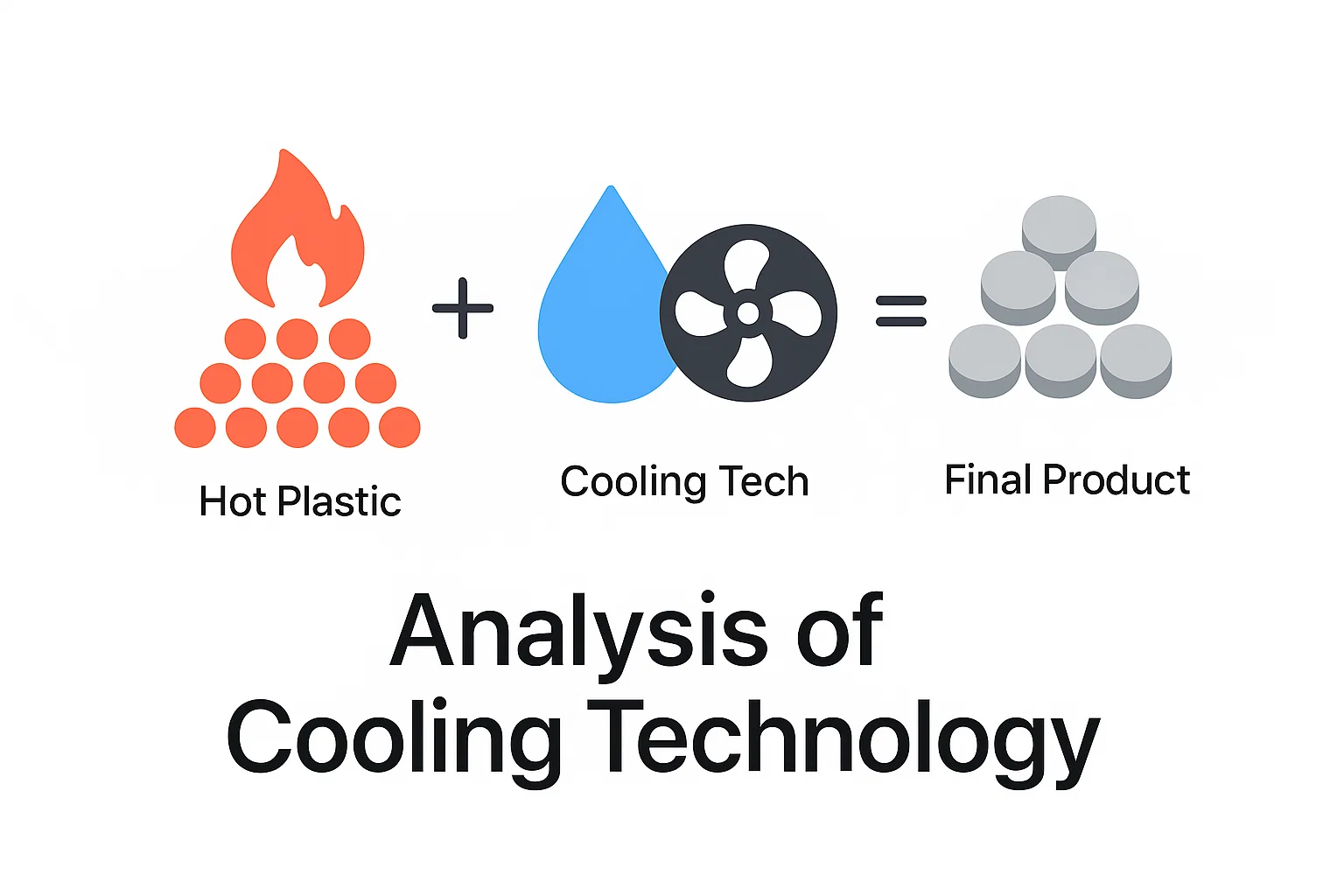In the world of plastic recycling, the journey from waste material to high-quality, reusable pellets is a testament to precision engineering. While the extruder and cutter of a máquina de pelotização de plástico often take center stage, the cooling process that follows is equally critical. It is the silent, yet decisive, phase that dictates the final quality, consistency, and structural integrity of the plastic pellets.
At Rumtoo, we believe that an informed customer is an empowered partner. Understanding the nuances of cooling technology is fundamental to selecting the right equipment for your operational needs. This comprehensive analysis will explore the principles, methods, and key considerations of cooling within the plastic pelletizing process, providing industrial professionals with the insights needed to optimize their production and enhance their final product.
Why Cooling is a Critical Stage in Plastic Pelletizing
After molten plastic is extruded and cut into pellets, it is still in a hot, malleable state. The primary function of the cooling system is to rapidly and uniformly reduce the temperature of these pellets. This controlled heat extraction is crucial for several reasons:
- Structural Integrity: Proper cooling solidifies the polymer chains, giving the pellets their required hardness and durability. Inadequate or uneven cooling can lead to internal stresses, resulting in brittle or misshapen pellets.
- Pellet Morphology: The cooling rate directly influences the final shape and size of the pellets. A well-designed system prevents pellets from sticking together (agglomeration) and ensures a uniform, free-flowing product that is ideal for storage, transport, and subsequent processing.
- Crystallinity and Properties: For semi-crystalline polymers like PET and HDPE, the cooling rate affects the degree of crystallinity. This, in turn, influences key physical properties such as density, tensile strength, and optical clarity. The goal is to manage the transition from the melt temperature (Tmelt) to below the glass transition temperature (Tg) with absolute control.
Essentially, the cooling system is where the desired physical properties of the recycled plastic are locked in.
An Analysis of Key Cooling Technologies
Cooling systems in the plastic pelletizing industry primarily fall into two main categories: water cooling and air cooling. Each has distinct methods and is suited to different applications and polymer types.
1. Water Cooling Systems: The Industry Standard
Water’s high thermal conductivity makes it an exceptionally efficient medium for heat removal. This method is favored for its speed and its ability to handle high-throughput operations.
- Water Strand Cooling: This is a classic and widely used method. Molten plastic strands are extruded from the die head and drawn through a water bath or trough. The cooled, solidified strands are then fed into a pelletizer, which cuts them into uniform pellets.
- Best for: Commodity plastics like Polypropylene (PP) and Polyethylene (PE).
- Advantages: Simple design, cost-effective, easy to operate and maintain.
- Considerations: Requires a dewatering and drying system to remove residual moisture, which can add to the footprint and energy consumption.
- Pelotização de anel de água: In this system, a rotating cutter slices the molten polymer as it exits the die face. The hot pellets are immediately thrown outwards into a circulating ring of water. The water cools and transports the pellets to a centrifugal dryer.
- Best for: High-volume production of non-hygroscopic materials.
- Advantages: Highly automated, compact design, produces uniform spherical or elliptical pellets.
- Considerations: Not ideal for moisture-sensitive plastics unless a highly efficient drying system is integrated.
- Underwater Pelletizing (UWP): As the name suggests, the cutting process happens directly at the die face, which is submerged in a chamber of flowing water. The pellets are cut and instantly solidified, then transported in the water slurry to a dryer.
- Best for: A wide range of polymers, including heat-sensitive and sticky materials like PET, Polystyrene (PS), and certain thermoplastic elastomers (TPEs).
- Advantages: Produces exceptionally uniform, high-quality pellets with minimal dust. The closed-loop system minimizes operator exposure to fumes.
- Considerations: This represents a higher initial investment and has greater mechanical complexity compared to strand systems.
2. Air Cooling Systems: The Specialist Choice
Air cooling is the preferred method for plastics that are highly sensitive to moisture, where even minimal residual water can compromise the material’s integrity during subsequent processing.
- Air-Cooled Pelletizing: In this setup, strands are extruded onto a conveyor belt, which is typically perforated. Fans blow ambient or chilled air over and through the strands to cool them before they reach the pelletizer.
- Best for: Highly hygroscopic (water-absorbing) polymers such as Polyamide (PA), Polycarbonate (PC), and certain grades of PET.
- Advantages: Eliminates the need for a drying stage, simplifying the process and reducing energy costs associated with moisture removal.
- Considerations: Cooling is significantly slower than with water, which limits the production throughput. The system also requires a larger footprint to allow for adequate cooling time on the conveyor.
Comparative Analysis: Water vs. Air Cooling
| Feature | Water Cooling Systems | Air Cooling Systems |
| Cooling Efficiency | Very High | Low to Moderate |
| Production Throughput | Alto | Baixo |
| Qualidade do pellet | Excellent, very uniform (especially UWP) | Good, but can be less uniform |
| Ideal Plastics | PE, PP, PS, PET (UWP) | PA, PC, moisture-sensitive PET |
| Operational Costs | Moderate (water treatment & drying energy) | Low (no drying needed) |
| Initial Investment | Varies (low for strand, high for UWP) | Moderate |
| System Footprint | Compact to Moderate | Grande |
| Vantagem principal | Speed and high production capacity | Avoids moisture contamination |
How to Select the Right Cooling System for Your Plastic Pelletizing Machine
Choosing the correct cooling technology is not a one-size-fits-all decision. It requires a careful evaluation of your specific operational parameters:
- Tipo de Material: Sua matéria-prima primária é higroscópica? Se você processa PA ou PC, um sistema de resfriamento a ar é quase certamente a melhor escolha. Para poliolefinas padrão, como PE e PP, um sistema de cordão de água ou anel de água oferece um excelente equilíbrio entre custo e desempenho.
- Taxa de Produção Requerida: Para usinas de reciclagem de alta capacidade, as taxas de resfriamento rápidas dos sistemas à base de água são essenciais para acompanhar as demandas de produção.
- Requisitos de Qualidade do Pellet Final: Se seus clientes exigem pellets perfeitamente esféricos sem partículas finas, um pelletizador subaquático é uma escolha premium. Para aplicações de uso geral, o resfriamento por cordão geralmente é suficiente.
- Orçamento e Custos Operacionais: Considere tanto o gasto de capital inicial quanto os custos operacionais de longo prazo. Embora um sistema resfriado a ar possa ter contas de energia mais baixas devido à ausência de um secador, sua menor taxa de produção pode afetar a lucratividade geral.
Na Rumtoo, nossa equipe técnica trabalha em estreita colaboração com os clientes para analisar esses fatores, garantindo que o máquina de pelotização de plástico e seu sistema de resfriamento integrado sejam perfeitamente adaptados aos seus objetivos comerciais.
Conclusão: O Resfriamento como Alicerce de Valor
O sistema de resfriamento é muito mais do que um acessório para um máquina de pelotização de plástico; é um componente fundamental que define o valor do seu produto reciclado. O domínio dessa tecnologia permite que os recicladores produzam consistentemente pellets de alta qualidade que atendam às exigentes demandas da manufatura moderna.
Seja a eficiência de um sistema de anel de água, a precisão de um pelletizador subaquático ou a aplicação especializada do resfriamento a ar a escolha certa para você, tomar uma decisão informada é o primeiro passo para maximizar seu retorno sobre o investimento.
Pronto para aprimorar sua capacidade de reciclagem de plástico? Entre em contato com os especialistas da Rumtoo hoje mesmo. Deixe-nos ajudá-lo a navegar pelas complexidades da tecnologia de resfriamento e desenvolver uma solução que ofereça desempenho e qualidade incomparáveis.
Perguntas Frequentes (FAQs)
Q1: Como o método de resfriamento impacta diretamente a qualidade dos pellets plásticos finais?
O método de resfriamento influencia a morfologia, cristalinidade e integridade estrutural dos pellets. O resfriamento rápido e uniforme (ex.: pelletização subaquática) produz pellets altamente consistentes, esféricos e com baixa tensão interna. Resfriamento lento ou irregular pode resultar em pellets deformados, aglomerados ou frágeis, causando problemas no processamento subsequente.
Q2: Qual é a diferença típica de custo operacional entre sistemas de resfriamento a água e a ar?
Geralmente, sistemas a ar têm custos operacionais mais baixos por não exigirem unidade de desumidificação e secagem, economizando energia significativa. Porém, sistemas a água oferecem taxa de produção muito maior. A solução mais econômica depende do equilíbrio entre economia de energia e volume de produção. Sistemas de cordão de água costumam ser os mais econômicos para plásticos não higroscópicos em grande volume.
Q3: Um único sistema de resfriamento pode ser usado para todos os tipos de plásticos?
Não, um único sistema não é universalmente ideal. O resfriamento a água é inadequado para plásticos altamente higroscópicos (ex.: náilon/PA) sem secagem excepcional, pois a retenção de umidade arruinará o material. Por outro lado, o resfriamento a ar é muito lento para produção em massa de plásticos comuns como PE e PP. A escolha deve corresponder ao polímero específico sendo processado.
Q4: Que tipo de manutenção é necessária para diferentes sistemas de resfriamento?
Sistemas a água exigem manutenção regular de bombas, filtros e sistemas de tratamento para evitar acúmulo de minerais e contaminação. A unidade de secagem (centrífuga ou vibratória) também precisa de verificações rotineiras. Sistemas a ar são geralmente mais simples, requerendo manutenção principalmente em ventiladores, filtros e esteira transportadora para garantir fluxo de ar e operação consistentes.

